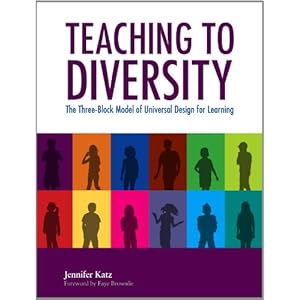To help us work towards our school goal of purposefully implementing the Universal Design for Learning approach to our formal planning (sometimes referred to as "Backwards by Design", "Understanding by Design", or "Planning With The End in Mind), my principal has provided our staff with a copy of Dr. Jennifer Katz's book, Teaching to Diversity: The Three-Block Model of Universal Design for Learning. As I make my way through the book, I will be summarizing my learning as a means of organizing my thoughts and getting clarification on particular ideas.
Teaching to Diversity Cover. (Accessed 2014). Uploaded to Amazon; Portage& Main Press.
Available online at: http://www.amazon.ca/Teaching-Diversity-Three-Block-Universal-Learning/dp/1553793536
The Planning Continuum
- Students need to connect concepts in order to develop deep
long-term understanding (teachers can set up year-long plans
to help accommodate this)
- Planning For The Year
- Try to set up an even number of units per term to ensure
that everything gets covered and you can easily manage
your time (combine connected units where needed)
- Set up units between different subject thematically in order
to build strong connections and big-picture thinking
- Ex. Human Impact (Social Studies) and Ecosystems
(Science)
- Easily done when multiple subjects are taught, but require
careful planning and open communication when done
between teachers
- Build in other subjects so that all subjects are included
- Determine what units will fit into what term. There may
be a natural skill progression or seasonal progression
- Strategies for Variations on The Year
- In multi-grade classrooms, teachers may build two-year plans
that allow them to cover both grades units over the two years or
combine similar units from both grades
- In one-class classrooms, teachers may collaborate with other
teachers
- Planning the Units
- Start with the end in mind and determine what assessments will
fit the needs of the students while covering the outcomes
- Understanding is a conceptual approach, which emphasizes
thinking
- Outcome is a skills-based approach, which emphasizes performance
- Determine essential understandings from each subject and then
combine to reach approx. 15 understandings for three units
- Creating Inquiry Questions
- Hook students in
- Build questions off of the essential understandings developed before
- Creating Rubrics for Assessment For, As, and Of Learning
- We need to assess using different methods to meet the needs of our
students but do not change standards for students
- Use your essential understanding as the highest level of your rubric
since it is essential, then use descriptive verbs to build the rest
- Give students input in the rubric in the sense that they revisit the
rubric and alter as necessary after the project/activity has already
been explored
- Use formative assessment to understand where your students are
starting from
- Make sure you incorporate multiple intelligences and don't "teach to
yourself". A lot of times, teachers who are musically-inclined incorporate
a lot of music in their rooms, kinaesthetic incorporate movement, etc
* Case Study: Sara (music lyrics)
- Planning Lessons
- Follow a pattern that allows for a gradual release of responsibility
* Case Study: Karl and Mitchell (memorized rap lyrics)
* Case Study: Nate and Michael (industry)
Literacy Across The Curriculum
- Covering topics thematically can help a student's literacy because they
have a basis to build vocabulary off of
- Reading fluency means they can recognize 95% of the words
- Don't get into the trap of grouping by ability level
- Buy 5 copies of 6 varied books about the same theme
Numeracy and Integration
- Making sure to include math in your thematic approach drastically
strengthens the ability to make connections and helps ensure that
math concepts are not taught in isolation
- Ex. Teaching about the north in Grade 4 Social Studies, practice
fractions to demonstrate the population of First Nations, Metis,
Inuit, and Other - Fraction in food groups - Create a song using
a certain beat
_____________________________________________
I WANT TO KNOW:
How closely do you include math in the thematic approach?
I feel like math has a more specific skill progression that needs to be incorporated and this may not fit naturally into a thematic approach.
Please leave your thoughts below :)
Labels: professional development, S-School, T-Division, U.D.L

